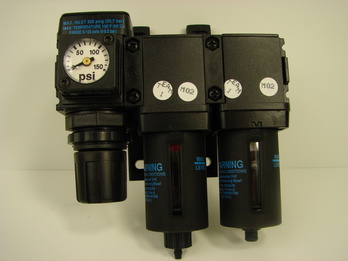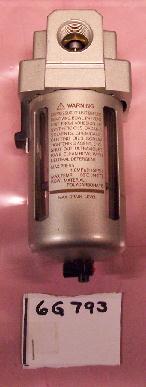|
Do you want to be a better CNC'er in 37 Seconds? Get Better Tool Life, Surface Finish, and Material Removal Rates Fast. It's that easy. You can install and get results now. |
Shop Air System, Part 2
Which Compressor?
That Sears Craftsman 2 hp 33 gallon vertical compressor had done an excellent job for me, but I wanted a better compressor. I wanted a stationary/fixed compressor with more horsepower, and my choices basically boiled down to whether to purchase a 2 stage model or get crazy and buy a rotary screw compressor. The latter, BTW, are truly the cat's meow. They're much quieter, last forever, and produce ridiculous amounts of air very efficiently. There's just one unfortunate drawback, and that is price. A lower end rotary screw compressor costs about $3500 whereas a nice 2-stage compressor is more like $1200. For my budget, that made the decision easy.
I wound up buying an Eaton 5 hp 2-stage 60 gallon unit. The offer a choice of colors, so I selected Ford Blue. This unit will put out 17 CFM @ 175 psi, which is more than enough for my needs considering the old compressor pretty well did the trick without running out of oomph and had less than half the capacity.
Eaton 5 hp 2-stage compressor under the house...
Distribution Plumbing Notes
There are several approaches to choose from when it comes to plumbing. Ingersoll Rand makes a cool slip together system called Simplair that uses aluminum pipe (good because it condenses the water out) and has slip together fittings. The latter means no need for threading or sweat soldering the pieces together. OTOH, Simplair would not be cheap.
Another approach is to use copper tubing, sweat soldered together. I have seen the majority of good home air systems done this way. The third approach is threaded black pipe. This is the strongest approach in terms of its ability to handle pressure. Our local Orchard supply will cut the pipe to length and thread the ends for free as well, which is nice. The other nice thing about using copper or black pipe is that I can just run down to the hardware store and buy a fitting or more pipe if I need to add something to my system, whereas with Simplair, I have to place an order and wait for it to arrive. In addition, I note that Harbor Freight has an inexpensive electric pipe threading machine available, so I took the black pipe approach. One approach to be avoided in any case is PVC pipe, which has a tendency to become brittle and eventually burst while spreading dangerous shrapnel in the shop.
Part of the deal with getting a new compressor is I have promised the old compressor to my brother. So as not to keep him waiting too long, I wanted place the new compressor into service just as the old one was and build the distribution system to run from that location back to where the compressor will eventually be located. I will admit this is somewhat backwards, but if you've read these pages for very long, you will realize I have to plan my projects on the notion they will move in fits and starts and the overall elapsed time can be ridiculously long for the easiest things.
Lastly, I want to added a refrigerated dryer to my system. Dryer air is better from every standpoint, and a refrigerated dryer does a good job getting most of the moisture out of the system right up front. Harbor Freight makes one of these too that is very reasonable, and I have heard good recommendations for the unit on a number of boards. I took a look at one the last time I was in their store and it looked pretty well made so far as I can tell.
Distribution Diagram
Here is my plan with respect to the distribution system for my shop:

As you can see, a fair amount of the system is designed to eliminate any water. The dryer should pull the lion's share of moisture out of the system, but I'm still planning to slope the overhead distribution line (1" black pipe) and provide water drains at the low points. The individual drops will be 1/2" black pipe, except for the drain drops which will be 1". The valves will all be ball valves. I need to find a source for the filter/oiler/regulator assemblies, but the system is pretty simple in its design.
Note: A good and cheaper alternative to a dryer is to simply add an aftercooler to your compressor system. It won't get the air quite as dry, but even if you add a real refrigerated dryer later, it is a worthwhile addition.
I've been advised that there needs to be a pretty good filter upstream of the dryer to keep the crud out of it. A coalescing filter is what Eaton recommends and others have mentioned a 5 micron or better filter of some sort.
For the individual stations, I found these Wilkerson units that combine a filter, regulator, and oiler on eBay for a good price:

Wilkerson R08-02-F0G0 Filter/Regulator/Oiler...
These are 1/4" NPT fitting units. I bought a couple of extra of the Wilkerson units because I may be expanding my shop at some stage and wanted to have some spares.
For the main filter right of the compressor, I went with a SMC NAF4000-N04, which is 1/2" NPT:

How it Turned Out
Typical air drop. Drain at bottom, individual valves for each outlet, and a filter/regulator unit for each outlet...
Got a hard to reach place? Just use flexible air hose. This run goes up and over a garage door and was much easier and cheaper than running black pipe over what was a pretty long distance to get to one air drop...
Here is the air distribution for my CNC mill. One line supplies all functions...
All functions at this point consists of my coolant mister, a handheld nozzle, and my little butterfly impact wrench...
Other Tips
Try to Test Out Sections of Your System for Leaks
I went with black pipe, and luckily tested sections for leaks. There were a few! I was also lucky to have done this before actually bolting things down. I waited until all leaks were fixed before bolting down each section.
Use Pipe Dope, not Teflon Tape!
Pipe Dope seals better than Teflon tape. Most places actually prohibit use of the tape on gas lines for this reason and because the tape can break off inside and wedge in a valve seal which makes the valve leak. However, soldered copper seals even better. If I had it to do all over again, I would be very tempted to go for the copper!
Want More Shop Projects?
Try our Blog and our Projects Page.
|
Do you want to be a better CNC'er in 37 Seconds? Get Better Tool Life, Surface Finish, and Material Removal Rates Fast. It's that easy. You can install and get results now.
|
||||||||||||||||||
| ||||||||||||||||||